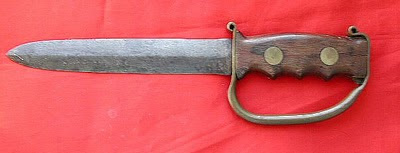
This is a nice little theater dagger with a d-guard made from copper or brass tubing.
The more I looked at it the more I liked it. This (to me) is what it's all about - the theater knife thing.
Some guy, with suddenly acquired shop-space and raw materials courtesy of Uncle Sugar, can make themselves a shank - or go into business making them for others.
 This one was, I think a one-off. Nothing about it says, to me, "production".
This one was, I think a one-off. Nothing about it says, to me, "production".This guy wasn't the only craftsman using tubing for the guard either.
It seems like a good idea - using tubing and I guess it is - it's easy to use. It just doesn't make the thing a "knuckle-knife".
What's nice about the tubing is that it bends easily. Big breakthrough there.
Problem; it bends so easily that it buckles.
No worries. the hardware store sells these little springy things that make it bend evenly. A buck or two each.
Or, and I tried this out (It worked as far as the tubing staying intact goes), another old-school technique is to pound the tube full of sand, seal off the ends and then it will either bend evenly or blow-out somewhere. And the sand adds some heft.
Another trick I have yet to try is to put a kerfed dowel into the tube. It doesn't matter.
The problem isn't getting the bend. It only appears at the ends where the tube is flattened so that the tang can pass through. All the inherent rigidity of the tube-shape is lost and what remains is a thin (far, far less than 1/8") strip of copper, the stiffness of which is further compromised by its being made up of two layers.
It has to be either left as worked - after the curlicues and such - which is to say; "Work-Hardened" or it can be annealed.
From the bottomless mind of Wiki:
Copper is easily softened by heating and cooling (it does not harden by quenching, as in cool water). In this annealed state it may then be hammered, stretched and otherwise formed, progressing toward the desired final shape, but becoming harder and less ductile as work progresses. If work continues beyond a certain hardness the metal will tend to fracture when worked and so it may be re-annealed periodically as the shape progresses. Annealing is stopped when the workpiece is near its final desired shape, and so the final product will have a desired stiffness and hardness.

Annealed or not, the metal will flex at the stress points and will ultimately become work-hardened there, regardless - especially if you insist on bending the guard back every time it deforms
I'd never really thought about this - the inherent unsuitability of tubing for this purpose. It doesn't really matter. I suspect that initially - early 19th century - the d-guard was thought of as knuckle protection more so than as an offensive feature.
When all this is factored against cold reality, the fact that knuckle-knives are still mostly just TBA (Travis Bickell Accessories), the structural shortcomings becomes less of an issue.
No matter. Everyone needs a knife and the bells and whistles accrue after that.
So, back in the day, WW2, every body had knives. Had to have them.
Go here for photographic proof. Every body and his dog with a big knife. Somewhere in there is a photo of Mickey Rooney at a USO show - with a BFK on-board. Andy Hardy goes tactical.
But I digress; This metallurgical flaw may be best illustrated by the knife at the top.

This is the top photo with the guard skewed - look at that mustard colored triangle, that much - and I'm thinking that this may have been more what he had in mind.
I know you've been waiting. Just, keep your seats people. Here it is, my version.

The knuckle-bow on the original was too small. Someone had to say it.
I made mine out of 3/8" round. Solid.
The rivets are poured-lead, like those on the knives of John Ek. Handle slabs are Bubinga (African Rosewood - which sounds cooler - oxymoron or no).
This job brought its own nostalgia hit as well.
Below, some "early work" that this project brought to mind.

We'll deal with the off-topic knife first.
The one on the right: Let's just say; "You've got to have some solid, brass nuts to put one of these together".
Oh God, it's true - and they were multiple dollars EACH.
But, brass nuts were purchased, mistakes were made. Let's move on shall we.
The other knife in the pic (The best knife I've ever made for throwing - not that throwing a knife isn't stupid - it is. It's just; we all do it. Guys do it. Should'a clarified that.
And it is dumb. Anyway, that little knife is what this one reminded me of










2 comments:
Good stuff Dan, including the link to the "Old Photo" index. Any hints as to the origins/histories of the knives pictured that you didn't make?
I wish not agree on it. I over precise post. Especially the title-deed attracted me to review the whole story.
Post a Comment